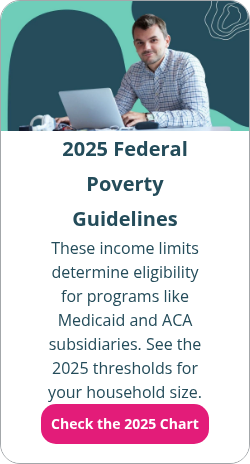Guide to premium tax credits for health insurance
By Elizabeth Walker on September 20, 2024 at 8:00 AM
If you’re new to shopping for health insurance, you may wonder how premium tax credits can help you lower your monthly premium payments. Knowing how to use tax credits to reduce healthcare costs is essential. Especially if you’re on a budget or have chronic medical conditions. But what is a premium tax credit, and how do they affect how much you’ll pay for coverage?
In this article, we'll cover premium tax credits, who qualifies for them, and how to calculate how much you can expect to pay for health insurance.
In this blog post, you’ll learn:
- How premium tax credits help reduce monthly health insurance costs.
- How federal guidelines have changed and expanded tax credit eligibility criteria.
- How to coordinate premium tax credits with health reimbursement arrangements (HRAs).
What is a premium tax credit?
Premium tax credits, or health insurance premium subsidies, are federal subsidies that the Affordable Care Act (ACA) created in 2014. These tax credits reduce eligible individuals’ monthly premiums, making health insurance coverage more affordable.
You can get premium tax credits on your federal income tax return. You can also choose to receive advance credits to help pay your monthly insurance premiums throughout the year.
Premium tax credits have eligibility requirements. The subsidy provides financial assistance for lower-income Americans to buy self-only or family coverage on the individual market. However, eligible individuals must buy an ACA-qualifying health plan on a public exchange to receive tax credits. Public exchanges are the federal Health Insurance Marketplace and state-based marketplaces.
How do I qualify for a premium tax credit?
Initially, people with an annual income range between 100% and 400% of the federal poverty level were eligible for credits if they weren’t offered affordable coverage through an employer or government program, like Medicare or Medicaid.
Financial savings depended on your household size and your income in relation to the federal poverty level. The subsidy would cap your health insurance costs between 2% and 9.5% of your income.
But, the American Rescue Plan Act of 2021 expanded subsidy eligibility. Now, all Americans who buy health insurance on a public exchange will pay no more than 8.5% of their actual household income for the silver-level benchmark plan.
These enhanced tax credits were set to expire at the end of 2022. But, the Inflation Reduction Act of August 2022 extended them through 20251.
Here's how the old income requirements compare to the current rules.

“Premium tax credits are particularly helpful for those who don’t qualify for Medicaid or employer-sponsored plans,” Adrien Kallel, CEO & Co-Founder of Remote People, said. “But, they’re based on your annual income level. So, if your income changes mid-year, your credit can adjust. You should report any changes immediately to avoid tax surprises.”
Can employees with group coverage get premium tax credits?
Employees with employer-sponsored coverage are only eligible for tax credits if their premiums are unaffordable. Before, affordability tests only used the employee’s income and the cost of a self-only plan—not their household income and the family plan cost.
This means if the employee had affordable coverage, their eligible family members would be ineligible to receive tax credits for an ACA health plan. This was known as the "family glitch."
In October 2022, the federal government created new rules to fix the family glitch. The affordability calculations now use household income and the cost to cover the employee and their eligible family members. Even if the employee accepts the employer-sponsored plan, their family can still decline it and enroll in subsidized marketplace insurance.
Can immigrants get premium tax credits?
Lawfully residing immigrants with an actual income below federal poverty guidelines can also receive tax credits if they aren't eligible for Medicaid or the Children’s Health Insurance Program (CHIP). Undocumented immigrants aren’t eligible for federal premium tax credits. But, some states offer tax credits to these individuals so they can buy health coverage2.
These six states expanded state-funded coverage to income-eligible adults regardless of immigration status:
The following states provide state-funded coverage for children regardless of immigration status:
- California
- Connecticut
- Colorado (starting in 2025)
- District of Columbia
- Illinois
- Maine
- Massachusetts
- Minnesota (beginning in 2025)
- New Jersey
- This state also offers state-funded plans to income-eligible pregnant people regardless of immigration level.
- New York
- Oregon
- Rhode Island
- Utah
- Vermont
- This state also provides state-funded coverage to eligible pregnant people regardless of immigration level. Coverage extends for 12 months postpartum.
- Washington
How do I figure out my premium tax credit?
Several online tools can help you calculate your premium tax credit. One of the most effective is KFF's Health Insurance Marketplace Calculator3. This tool estimates what you will pay for health insurance. It will also show your eligibility for tax credits based on personal information.
We'll walk you through how it works.
How to use the health insurance premium and tax credit calculator
First, open the KFF Marketplace calculator. Once there, enter your basic personal information and click submit when you finish.
The information you'll enter includes:
- State
- ZIP code
- Actual household income
- Whether you have employer-sponsored coverage
- Total number of people in your family
- Number and ages of adults in your family
- Number and ages of children in your family
- Whether you are a tobacco user
These are all factors that can affect how much of a subsidy you can claim. Be sure to enter the information as accurately as possible to estimate your financial savings correctly. You can estimate your yearly income and modified adjusted gross income (MAGI).
Example for a single adult in Arkansas earning $52,000 per year
Let's take a look at an example so you can see how it all works.
Below is a health insurance premium and tax credit estimate for a single individual in Arkansas earning $52,000 per year.


This example shows the difference the Inflation Reduction Act made on monthly premiums for those on the edge of the subsidy cliff.
Before, a single adult in Arkansas making $52,000 would still have qualified for a premium tax credit because their income is 357% of the poverty level. But, the Inflation Reduction Act simplifies the calculation and offers greater savings.
|
Subsidized cost for the second-lowest-cost silver self-only plan |
Unsubsidized cost for the second-lowest-cost silver self-only plan |
|||
|
Household income |
Premium tax credit |
Actual premium |
Household income |
Actual premium |
|
$52,000/year |
$663/month (or $7,952/ year) |
$309/month ($3,708/year) |
$52,000/year |
$972/month (or $11,659/year) |
Example for a family of three in Utah earning $70,000 per year
Here's a health insurance premium and tax credit estimate for a family of three living in Utah earning $70,000 per year.


|
Subsidized cost for the second-lowest cost silver family plan |
Unsubsidized cost for the second-lowest cost silver family plan |
|||
|
Household income |
Premium tax credit |
Actual premium |
Household income |
Actual premium |
|
$70,000/year |
$1,738/month (or $20,861/year) |
$282/month ($3,388/year) |
$70,000/year |
$2,021/month ($24,249/year) |
If you qualify for a tax credit, using it can be an excellent way to lower your monthly healthcare costs.
How can I get my premium tax credits?
You must buy health insurance through the federal Health Insurance Marketplace or your state's marketplace to receive your tax credit. You don’t qualify for tax credits if you buy an individual policy on a private exchange. Examples of private exchanges are plans purchased from an insurance provider directly.
Keep in mind that public exchanges will display catastrophic plans. But, these plans aren't eligible for premium tax credits.
Individuals can buy a qualified health insurance plan during the annual open enrollment period. All states begin open enrollment on November 1 and end on January 15 or later. Outside of this time, you can only get health coverage during a special enrollment period (SEP) if you have a qualifying life event.
Many states use the federal Marketplace for enrollment. There, you can view and compare policies, enroll in a plan, and receive your premium tax credit. States with their own exchanges have similar websites where you can compare and enroll in plans and apply for tax credits. If you need help shopping for a plan, a broker specializing in ACA health insurance policies is a free resource for consumers.
Will I have to pay back my premium tax credit?
If you receive premium tax credits, you don't have to pay the credit back during tax time. Instead, you'll receive a refundable credit after you file your tax return and IRS Form 89624. But, the process works differently if you receive advance premium tax credits (APTCs).
If you’ve taken fewer advance payments than you were eligible for based on your final yearly income, you’ll receive a tax refund. If you took the right amount of APTCs, you won’t receive an income, nor will you owe anything extra. But, if you've taken more advance payments than you’re eligible for, you must pay the excess back to the IRS on your federal income tax return.
This process of comparing the amount of tax credits you used to the actual credits you qualified for is called reconciling5.
These three steps show you how to reconcile your tax credits:
- Find your Form 1095-A, which is your Health Insurance Marketplace Statement.
- Login to your account on HealthCare.gov or your state exchange to download Form 1095-A. You should also receive a copy in the mail.
- Use the information from Form 1095-A to fill out Form 8962.
- Once filled out, you'll see the amount you’ll owe or how it will reduce your refund for the tax year.
- Attach Form 8962 to your federal tax return before filing.
- Form 1095-A is for your records. You don't have to attach it to your return.
Suppose you received APTCs but didn’t reconcile your tax credits on your income tax return. In that case, you may be ineligible to receive health insurance subsidies for future ACA marketplace coverage.
If you need help filing your tax forms, consult a tax advisor for professional assistance or if you have additional questions.
Can I coordinate premium tax credits with HRAs?
Health reimbursement arrangements (HRAs) allow employers to reimburse employees tax-free for individual health plan premiums and qualified out-of-pocket costs. With an HRA, employers set a monthly allowance that their employees can use for healthcare. Employees buy their preferred individual health plan and other medical services. After they incur an approved expense, their employer reimburses them tax-free up to their allowance amount.
HRAs allow employees to choose the individual health coverage and medical care that best meets their needs. But what if these employees qualify for premium tax credits? How can they take advantage of an HRA?
Because HRA allowances pay for monthly health insurance premiums with tax-free money, eligible employees must coordinate their allowance with tax credits. But, this process varies depending on the type of stand-alone HRA you have.
Here’s how premium tax credits work with HRAs:
- For 2026, your qualified small employer HRA (QSEHRA) allowance is affordable if you’re paying no more than 9.96% of your actual income for the second-lowest-cost silver plan premium on the Marketplace. You calculate this after you factor in your QSEHRA allowance6.
- If your QSEHRA is affordable for a given month, you can’t collect your tax credits for that month.
- If your benefit isn’t affordable for one or more months, you can collect your credits (if you’re eligible). But you must reduce your subsidy by the amount of your allowance.
- For an individual coverage HRA (ICHRA) to be affordable in 2026, you must not pay more than 9.96% of your actual income for the lowest-cost silver plan on a public exchange. Unlike the QSEHRA, you must choose between the ICHRA or your premium tax credits—you can’t receive both.
- You should waive your tax credits and opt into the ICHRA if your benefit is affordable.
- If it’s not affordable, you can opt out of the ICHRA and collect your premium tax credits. If you opt out of the ICHRA and the benefit is affordable, you won’t be able to receive your tax credits.
Conclusion
Premium tax credits are a valuable way to lower the cost of health insurance, especially for low-income families. More Americans can now receive financial assistance for affordable coverage. By following this guide, you can calculate and claim your premium tax credits to get the most bang for your buck.
If you’re an employer looking to help your employees with their premium costs, offer them an HRA. This helps them pay for their medical expenses. Schedule a demo with a PeopleKeep HRA specialist today to learn how a QSEHRA or an ICHRA can benefit your staff.
This blog article was originally published on November 17, 2014. It was last updated on September 20, 2024.
Check out more resources
See these related articles

What is a health insurance subsidy?
Discover the ins and outs of health insurance subsidies with this comprehensive overview. Learn how they can help make healthcare more affordable for you.

State-by-state guide to health insurance marketplaces
Looking for health insurance options in your state? This comprehensive guide provides a state-by-state breakdown of health insurance marketplaces.

The least and most expensive states for individual health insurance
Individual health insurance can be pricey, especially in these top 10 states. See the locations where rates are highest and how you can save on coverage.



